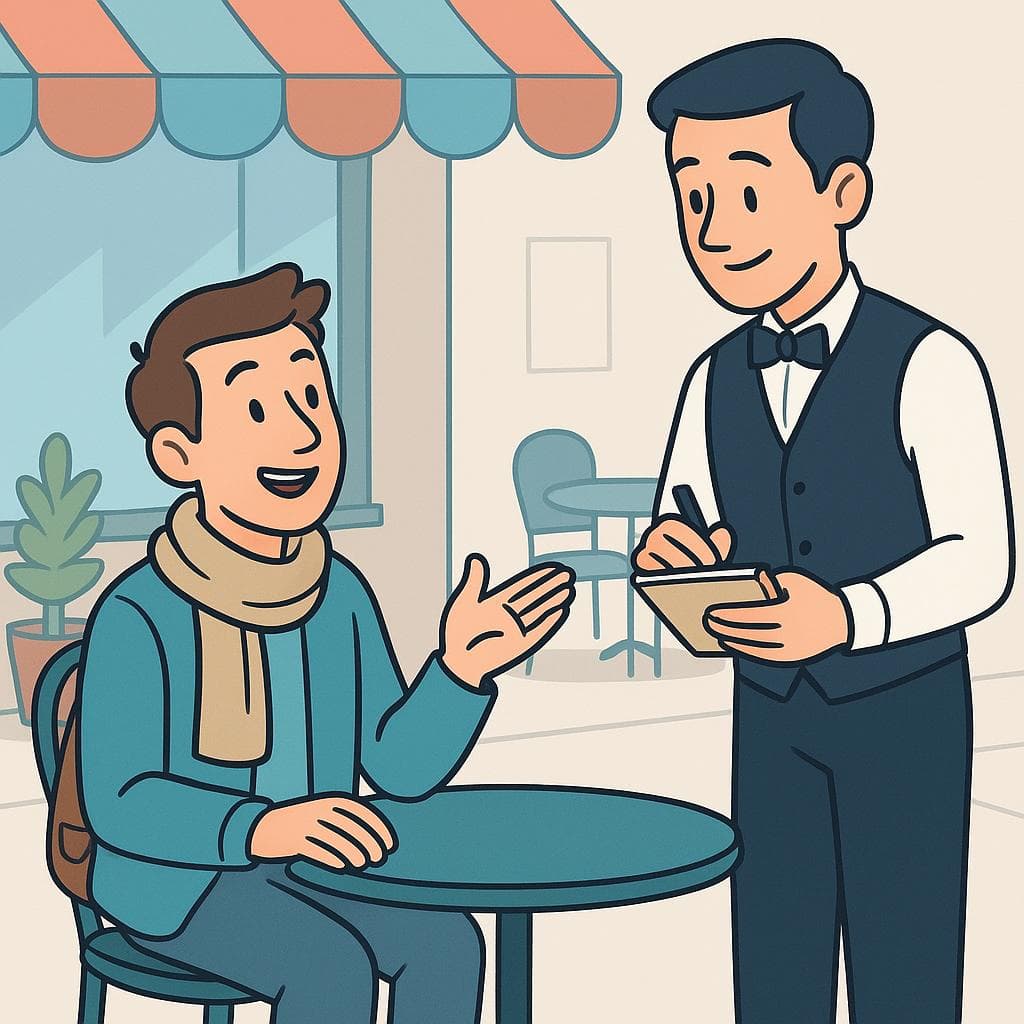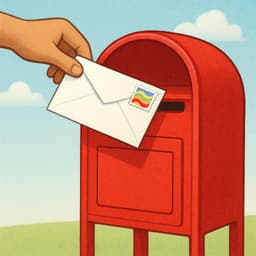The menu, please
in SpanishLa carta, por favor.
/lah CAR-tah, por fah-VOR/
This is the most standard and universally understood way to ask for the menu in any Spanish-speaking country. 'Carta' is the classic word for a restaurant's full list of food and drinks.

Knowing how to ask for the menu is your first step to a delicious meal in any Spanish-speaking country.
💬Other Ways to Say It
El menú, por favor.
/el meh-NOO, por fah-VOR/
This is also extremely common, especially in Mexico and much of Latin America where 'menú' is used interchangeably with 'carta' for the main menu. Be aware that in Spain, this specifically asks for the 'menú del día' (the daily special).
¿Me trae la carta, por favor?
/meh TRAH-eh lah CAR-tah, por fah-VOR?/
A more complete and polite sentence that translates to 'Could you bring me the menu, please?'. Using a full question like this sounds slightly more formal and fluent.
¿Nos trae la carta, por favor?
/nohs TRAH-eh lah CAR-tah, por fah-VOR?/
This is the plural version of the above, used when you are dining with other people. 'Nos' means 'us,' so you are asking for menus for the whole table.
¿Me puede traer el menú, por favor?
/meh PWEH-deh trah-EHR el meh-NOO, por fah-VOR?/
Another very polite, full-sentence way to ask, meaning 'Can you bring me the menu, please?'. It's functionally identical to '¿Me trae...?' and is a matter of personal preference.
Cuando pueda, la carta.
/KWAN-doh PWEH-dah, lah CAR-tah/
A more indirect and relaxed way to ask, meaning 'When you can, the menu.' It's polite because it acknowledges that the server might be busy.
🔑Key Words
Key Words to learn:
📊Quick Comparison
Here's a quick guide to choosing the best phrase for asking for the menu based on the situation.
| Phrase | Formality | Best For | Avoid When |
|---|---|---|---|
| La carta, por favor. | Neutral | Almost any situation, especially in Spain for the full menu. | It's never wrong, but a full sentence might sound more polite. |
| El menú, por favor. | Neutral | Casual restaurants in Mexico and Latin America. | In Spain, unless you specifically want the daily set menu. |
| ¿Me trae la carta, por favor? | Formal | Sit-down restaurants where you want to be extra polite. | A very casual street food stand or a loud, busy bar. |
| Cuando pueda, la carta. | Casual | A busy cafe or restaurant to show you're not in a hurry. | A very formal or high-end dining establishment. |
📈Difficulty Level
Fairly easy for English speakers. The 'r' in 'por favor' and 'carta' is a simple tap, and the 'v' sounds like a 'b'. The rolled 'rr' in 'traer' is the only minor challenge.
The basic phrase 'La carta, por favor' involves no complex grammar. It's just a noun and a polite expression.
Understanding the difference between 'carta' and 'menú,' especially in Spain, requires some cultural knowledge. Knowing the proper etiquette for getting a server's attention is also important.
Key Challenges:
- Remembering to use 'la carta' in Spain for the main menu.
- Knowing which formality level to use (simple phrase vs. full question).
💡Examples in Action
Buenas tardes. Mesa para dos. La carta, por favor.
Good afternoon. Table for two. The menu, please.
Disculpe, ¿nos puede traer la carta cuando tenga un momento?
Excuse me, could you bring us the menu when you have a moment?
Ya hemos terminado el plato principal. ¿Nos trae la carta de postres, por favor?
We've finished our main course. Could you bring us the dessert menu, please?
Hola, ¿podríamos ver el menú antes de sentarnos?
Hi, could we see the menu before we sit down?
🌍Cultural Context
'La Carta' vs. 'El Menú'
Technically, 'la carta' is the full à la carte menu with all options. 'El menú' often refers to the 'menú del día,' a fixed-price daily special common for lunch in Spain and other countries. However, in Mexico and much of Latin America, 'el menú' is commonly used to mean the main menu, making the two terms interchangeable there.
Getting the Waiter's Attention
In the Spanish-speaking world, it's considered rude to shout or snap your fingers to get a server's attention. The polite way is to try to make eye contact, give a slight raise of the hand, or say a quiet 'Disculpe' (excuse me) or 'Perdón' when they are nearby.
The Importance of the 'Menú del Día'
In Spain, the 'menú del día' is a cultural institution. It's a multi-course lunch offered on weekdays at a set price, usually including a starter, main course, dessert or coffee, and a drink. If you ask for 'el menú' in Spain, this is what you'll almost certainly get.
A More Relaxed Pace
Dining culture in many Spanish-speaking countries is often more leisurely than in the US or UK. Don't be surprised if the service seems slower; it's part of a culture that values enjoying the meal and conversation without being rushed. The bill ('la cuenta') will usually only be brought when you ask for it.
❌ Common Pitfalls
Forgetting 'Por Favor'
Mistake: "Just saying 'La carta.'"
Correction: Always say 'La carta, por favor.'
Mixing Up 'Carta' and 'Menú' in Spain
Mistake: "Asking for 'el menú' when you want to see all the available dishes."
Correction: Ask for 'la carta' for the full menu.
Using the Wrong Verb
Mistake: "'¿Puedo tener la carta?' (Can I have the menu?)"
Correction: '¿Me trae la carta?' or '¿Me puede traer la carta?'
💡Pro Tips
When in Doubt, Start Simple
'La carta, por favor' is your golden phrase. It's simple, polite, and works everywhere. Master this one first before moving on to the more complex sentence variations.
Always Add a Greeting
Before you even ask for the menu, make sure to greet the staff with 'Hola,' 'Buenas tardes,' or 'Buenas noches.' It sets a friendly and respectful tone for the entire interaction.
Be Specific if Needed
You can use the same structure to ask for other specific lists. For example, 'La carta de vinos, por favor' for the wine list, or 'El menú de postres, por favor' for the dessert menu.
Combine with a Smile
Non-verbal cues are just as important. A friendly smile and polite eye contact when you make your request will make the interaction smooth, even if your pronunciation isn't perfect.
🗺️Regional Variations
Spain
The distinction between 'carta' (full menu) and 'menú' (daily special) is very strong here. Asking for 'el menú' will almost exclusively get you the 'menú del día'. Politeness is key, but service can be direct.
Mexico
'Menú' is used far more frequently than 'carta' to refer to the main menu, even in nice restaurants. 'Carta' might be used for specific lists like 'carta de vinos' (wine list). Service is famously warm and hospitable.
Argentina
Argentinians use 'vos' instead of 'tú' for the informal 'you,' which changes verb forms (e.g., 'traés' instead of 'traes'). The overall vibe in restaurants is social and can be loud and lively.
💬What Comes Next?
After you ask for the menu
Enseguida. / Ahora mismo.
Right away. / Right now.
Gracias.
Thank you.
When they hand you the menu
¿Para beber? / ¿Quieren algo de tomar?
To drink? / Do you want something to drink?
Sí, para mí un agua, por favor.
Yes, for me a water, please.
After giving you a moment with the menu
¿Están listos para pedir?
Are you ready to order?
Sí, quisiera el pollo. / No, necesitamos un minuto más, por favor.
Yes, I would like the chicken. / No, we need one more minute, please.
🧠Memory Tricks
The similar sound between 'carta' and 'card' helps create a strong mental link to the idea of a list of choices.
This visual gag connects the sound of the word to its function in a memorable way.
🔄How It Differs from English
The biggest difference is that English has one word, 'menu,' while Spanish has two distinct concepts: 'la carta' (the full list of everything) and 'el menú' (often a fixed-price set meal, especially in Spain). While this distinction blurs in Latin America, it's a key piece of cultural knowledge for travelers. Additionally, directly translating 'Can I have...' is unnatural; the Spanish way is to ask the person to bring the item to you.
False Friends & Common Confusions:
Why it's different: Translating this as 'el menú' in Spain can lead to confusion, as you'll be given the daily special menu instead of the full à la carte menu.
Use instead: In Spain, use 'la carta' for the full menu. In Latin America, 'el menú' is generally safe to use for the main menu.
🎯Your Learning Path
➡️ Learn Next:
How to ask for the bill
This is the natural next step after you've finished your meal.
How to order food
Once you have the menu, you'll need to know how to actually order from it.
How to ask for water
This is one of the most common and essential things to order in a restaurant.
How to say 'excuse me'
You'll need this to politely get the waiter's attention in the first place.
✏️Test Your Knowledge
💡 Quick Quiz: The menu, please
Question 1 of 4
You're in a traditional restaurant in Madrid, Spain, and want to see all the food options available. What should you ask for?
Frequently Asked Questions
What's the real difference between 'la carta' and 'el menú'?
Think of 'la carta' as the big book with everything the restaurant ever makes (the à la carte menu). 'El menú' is usually a smaller, specific list for the day, like a lunch special ('menú del día'). While they are used interchangeably in Latin America, in Spain this difference is very important.
Is it rude to just say 'La carta, por favor' instead of a full sentence?
Not at all! It's perfectly polite and normal. Using a full sentence like '¿Me puede traer la carta?' is slightly more formal and shows more language command, but the short version is completely acceptable in 99% of situations.
What if I forget the word? How can I ask for the menu?
Don't worry! You can make eye contact with the server, smile, and make a gesture like you're writing on the palm of your hand. This is a universal sign for asking for the menu or the bill and will be understood everywhere.
How do I ask for the wine list or dessert menu specifically?
It's easy! Just swap out the main word. Ask for 'La carta de vinos, por favor' for the wine list, and 'La carta de postres, por favor' or 'El menú de postres, por favor' for the dessert menu.
Will they bring the menu automatically when I sit down?
In many places, yes, but not always. Sometimes, especially in a more casual cafe or a very busy restaurant, you may need to politely get the server's attention and ask for it yourself. It's not considered rude to have to ask.
Why does 'por favor' sometimes sound like 'porfa'?
'Porfa' is a very common, casual shortening of 'por favor,' similar to saying 'thanks' instead of 'thank you' in English. You'll hear it often among friends and in informal settings. As a learner, it's best to stick with the full 'por favor' to always be polite.
📚Continue Learning Spanish Phrases
Explore More Phrases in These Categories
Find similar phrases to expand your Spanish vocabulary:
Want to Learn More Spanish Phrases?
Browse our complete collection of Spanish phrases organized by situation, from basic greetings to advanced conversations. Perfect for travelers, students, and anyone learning Spanish.
View All Spanish Phrases →

